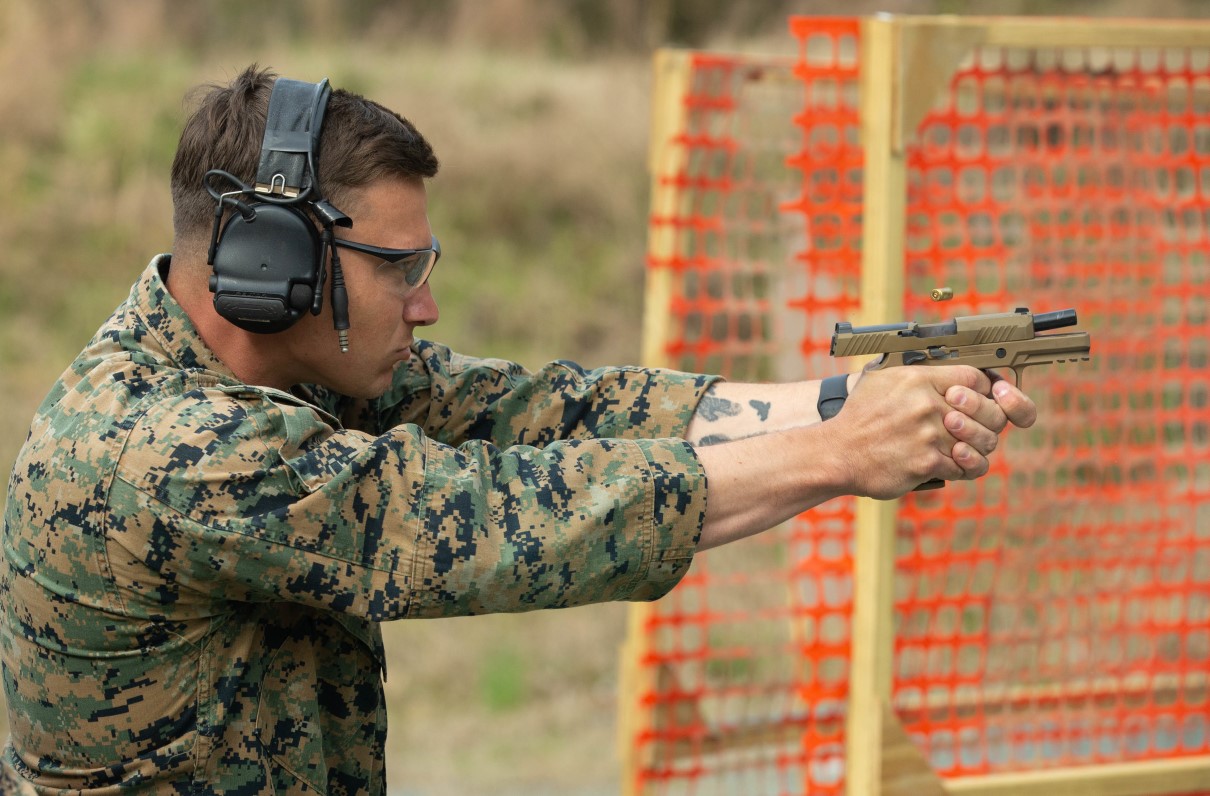This article by Rose L. Thayer originally appeared on Stripes.com. Stars and Stripes serves the U.S. military community by providing editorially independent news and information around the world.
MARINE CORPS BASE QUANTICO, Va. — Changes announced Monday to scoring and shooting standards for Marine Corps marksmanship requirements will better account for the speed at which a Marine shoots at a target, not just accuracy, according to service officials behind the decision.
The changes allow for a magazine-supported shooting posture and require higher scores to complete annual requirements at the prequalification phase of rifle training, according to an announcement sent to Marines.
For Marines who qualify on a pistol, which depends on a service member’s job, the first three qualification stages are becoming more difficult to better prepare Marines for the final two.
“This is about increasing lethality,” said Col. Gregory Jones, commander of the Weapons Training Battalion, part of Training Command at Marine Corps Base Quantico in Virginia. “This is not your granddad’s rifle range.”
He spoke last week about the changes alongside Chief Warrant Officer 4 Joshua Grayek, director of marksmanship in the battalion. Both described the overhaul as the largest since 1907.
“The rifle range in 1907, it’s not bad or good. It’s what we had when we had … a 1903 Springfield [rifle], which was an 1890s technology,” Jones said. “Now we have an M-16A4. The test is not as true a measure of lethality as it was when we had older, outdated technology.”
[RELATED: More Recommended Reads From MOAA]
The Marine Corps began reevaluating its marksmanship standards after a 2018 combat-based lethality assessment found skill gaps in the ability of Marines to shoot on the move or at a moving target at unknown distances.
With that in mind, Training Command evaluated how to better train and score Marines in how effectively they can shoot to kill with their weapons, and the command will use a $34 million program to score troops on shooting speed and accuracy. The Joint Marksmanship Assessment Program, or JMAP, provides detailed data that can then be used to create individual training programs to help Marines improve their skills.
Under the previous system, a Marine had two minutes to shoot 30 rounds at targets at the required distances. The final score was an aggregate that showed nothing of how quickly the Marine hit the targets or which distances proved most difficult. It also did not differentiate between body hits and fatal shots.
“With the new data redefining lethality, we can find out that he’s shooting 50 seconds faster than I am,” Grayek said, pointing to Jones. “That means he’s killing three or four bad guys in the time it takes me to kill one. He’s more lethal now, so that was the big paradigm shift.”
Each year, Marines must do a prequalification and a qualification on their rifle. In the past, the prequalification score could be accepted for both if it passed the standards at any of the three acceptable levels of marksman, sharpshooter or expert. Now, for a prequalification score to be accepted, it must be expert — the highest level available.
“You’re going to have to go back and try to better yourself,” Grayek said. “It’s a forcing function to make them not accept less than the best.”
Entry-level shooters can now support their rifle on the magazine while shooting, something that was previously banned. Jones credited better magazines for being able to allow the supported position that is acceptable in many civilian-shooting events.
“This is common in all our advanced marksmanship courses, and it’s common in high-end civilian marksmanship competitions. This is the start of experimenting with and permanently changing some of the ways we do it at entry-level marksmanship,” Jones said. “We hope it’s not overly emotional, because it shouldn’t be. There’s logical, functional reasons for why we’re making this change.”
[RELATED: Top Marine Returns to Full Duty Status After Cardiac Arrest Last Year]
Staff Sgt. Austin Hill, chief instructor of the Advanced Marksmanship Training Program at Quantico, said he’s seen the Corps turn marksmanship upside down to improve the ability of all Marines.
“We are trying to pull the best that we can be so that we can further the force as a whole and continue to move forward,” he said.
PREMIUM Membership Comes With So Many Benefits. Are You Taking Full Advantage?
Find out just how many benefits are waiting for you, and start using them TODAY.
